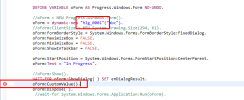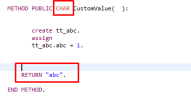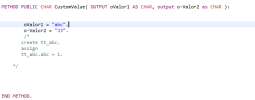Hello,
I am starting developing in OpenEdge GUI for .NET and i am trying to do a output parameter in a dialog.
How i can i have a output param after close the dialog?
Thanks,
Baltazar
I am starting developing in OpenEdge GUI for .NET and i am trying to do a output parameter in a dialog.
Code:
oForm = dynamic-new "hlg_0001"("abc").
oForm:FormBorderStyle = System.Windows.Forms.FormBorderStyle:FixedDialog.
oForm:MaximizeBox = FALSE.
oForm:MinimizeBox = FALSE.
oForm:ShowInTaskbar = FALSE.
oForm:StartPosition = System.Windows.Forms.FormStartPosition:CenterParent.
oForm:Text = "In Progress".
//oForm:Show().
WAIT-FOR oForm:ShowDialog( ).
oForm:Dispose( ).How i can i have a output param after close the dialog?
Thanks,
Baltazar





